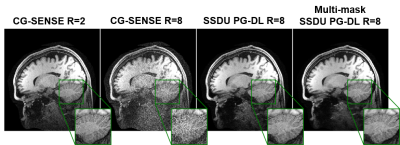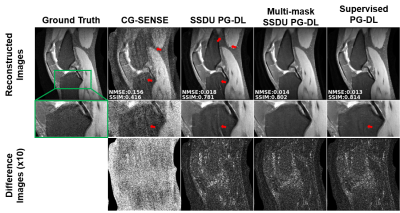Burhaneddin Yaman1,2, Seyed Amir Hossein Hosseini1,2, Steen Moeller2, Jutta Ellermann2, Kâmil Uğurbil2, and Mehmet Akçakaya1,2
1University of Minnesota, Minneapolis, MN, United States, 2Center for Magnetic Resonance Research, Minneapolis, MN, United States
1University of Minnesota, Minneapolis, MN, United States, 2Center for Magnetic Resonance Research, Minneapolis, MN, United States
The proposed multi-mask
self-supervised physics-guided learning technique significantly improves upon
its previously proposed single-mask counterpart for highly accelerated MRI
reconstruction.

Figure 3. A representative test brain MRI slice showing reconstruction
results using CG-SENSE, SSDU PG-DL and proposed multi-mask SSDU PG-DL at R=8,
as well as CG-SENSE at acquisition acceleration R=2. CG-SENSE suffers from major
noise amplification at R=8, whereas SSDU PG-DL at R=8 achieves similar
reconstruction quality to CG-SENSE at R=2. The proposed multi-mask SSDU PG-DL
further improves the reconstruction quality compared to SSDU PG-DL.

Figure 2. a) Reconstruction results on a representative test
slice at R = 8 using CG-SENSE, supervised PG-DL, SSDU PG-DL and proposed
multi-mask SSDU PG-DL. CG-SENSE suffers from major noise amplification and
artifacts. SSDU PG-DL also shows residual artifacts (red arrows) at this high
acceleration rate. Proposed multi-mask SSDU PG-DL further suppresses these
artifacts and achieve artifact-free reconstruction, removing artifacts that are
still visible in supervised PG-DL.